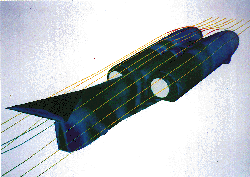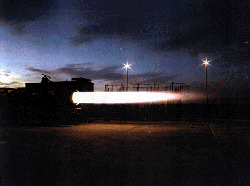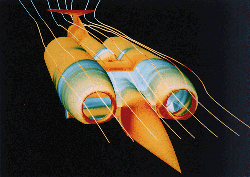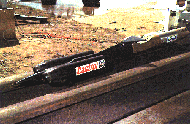The object is to design and build a car which is capable of breaking the World Land Speed Record (WLSR), and to set a new record in excess of the speed of sound. This should be achieved as safely as possible and in accordance with the F.I.S.A. regulations governing WLSR attempts.
The speed of sound at low level is about 750mph. In order to achieve an average (over one mile) in excess of this, the vehicle will reach a peak speed of about 800mph. To ensure a satisfactory margin we are aiming to provide a peak speed well in excess of 800mph.
Safety will be a paramount consideration, and all aspects of design, construction, testing and operation will take full account of this. We can build on the wealth of experience gained from the Thrust 2 project.
It is currently intended to run the vehicle at Black Rock Desert, Nevada, but other venues may be considered.

As a car gains speed it is subjected to aerodynamic forces which are large enough to invalidate the comforting asusmption that gravity will keep it on the ground. By the time transonic speeds are reached the aerodynamic influence is so large that gravity can provide no more than a small downwards bias to the resultant force. As an example of the overwhelming influence of aerodynamics, if the vehicle is travelling at 800mph and the pitch attitude is just 30 minutes excessively nose-up (relative to correct trim angle) it will take off. The resulting back-flip would destroy the suspension and would certainly increase rolling resistance, severely restricting the maximum speed achievable. It is clear from this that the pitch attitude of the vehicle must be very tightly controlled.
In practice it is difficult even to specify what the 'correct attitude' should be as there are several complicating factors. These are described below:
It is clear from this that the primary problem of designing a supersonic car is not performance (we can always put in bigger engines to go faster) but stability and control in the incredibly complex transonic region. This influences every aspect of the design.

Turbojet engines are favoured over rocket engines, partly because our experience is related to turbojet engines, and partly because rocket engines of suitable size and performance are not readily available. The Rolls-Royce Spey, used in the Phantom jet fighter, was selected despite being a relatively vulnerable design and having a modest thrust/weight ratio by modern standards. It was chosen because of its simplicity, robustness, ease of installation, availability of spares, and tremendous reliability record.
Detailed design studies showed that a twin engined layout gave substantial benefits, not just in terms of performance, but also in terms of stability and control.
The cockpit is a steel box, with extensive protection against fire, heat and fumes, and is situated between the front and rear engine mountings. Hence the surrounding structure is extremely strong and offers the driver very good protection in the event of an accident. This location is also close to the centre of gravity, giving the driver the best possible 'seat-of-pants' feedback of vehicle behaviour.

There is little experience to indicate the best shape for a transonic/supersonic car. Theoretical methods mostly break down in this flow regime - and certainly do not deal with ground effects. We can get some guidance from the transonic similarity law and from the transonic area rule. These indicate that, for performance reasons and subject to obvious structural limitations, the car should have a long slender shape, and the longitudinal distribution of cross-sectional area should be as smooth as possible. This long shape enables the provision of a long wheelbase - important for steering stability. The engines must be close together to minimise the problems caused by an engine flame-out. Good forward visibility from the cockpit is an essential requirement, and influences the detailed design of the nose and the front of the engine cowlings. We believe that all these conflicting requirements have been satisfied by the present design.
As previously stated, this is the crucial problem, and the vehicle configuration has largely been dictated by it. The twin engine configuration allows us to place the front wheels wide apart and the centre of gravity well forward. The result is good stability about all three axes, something that was not possible with our earlier single-engined configurations. Yaw stability is provided by a conventional aircraft-style tailfin, highly swept to minimise Mach Number effects. The horizontal fin, also well swept, is high-mounted to avoid the jet efflux. The suspension will keep the vehicle at the correct attitude at all times.

Steering is, very unusually, by the rear wheels. The layout is made even more unorthodox because, due to space restrictions, the rear wheels are asymetrically placed. Preliminary theoretical analysis indicated that this controversial arrangement can perform satisfactorily. Experimental verification was obtained by building and testing a rear-wheel steering vehicle.
The unsteady flow which charaterises the transonic region dictates that the structure must be very stiff indeed. This is ensured by a spaceframe made from welded steel tube. Its rigidity is further enhanced by the long dorsal fin and the tapered undertray which are integral parts of the rear structure. It is proposed that, before the first runs, the complete vehicle will be resonance tested to determine natural frequencies.
We return to the crucial problem of keeping the vehicle on the ground. The nose has been 'drooped' to give a net download, and the engine intake cowlings are similarly asymmetric in order to contribute to the download. As we learn more fom computational fluid dynamics and rocket testing, some modification to the outside shape may be indicated.
We have employed an orthodox cowl profile. This has good transonic drag rise characteristics. Also, its rather bulbous shape is large enough to encompass most of the frontal area of the front wheels. Thus, with only local modification to the cowl section, the front wheels are completely faired.
Our two Spey engines provide a total thrust of more than 20 tons. At full speed this is equivalent to over 100,000 horsepower, making it by far the most powerful car ever built. Acceleration figures are quite impressive - from zero to 600mph in 16 seconds. Initial performance computations show that the vehicle should comfortably achieve a supersonic record, and well within the 13 mile space available at Black Rock Desert. Indeed, it can travel from zero to 800pmh and back to zero again in only 7 miles. That 7 mile journey will take approximately one minute.

This project takes us into uncharted regions. The combination of high speed and structural loads, severe vibration, high temperatures and abrasion from desert particles means that conventional engineering solutions will often not be adequate. In the search for new solutions we are consulting experts in universities, research establishments and industry. To tackle the severe problems posed by transonic ground effect we have pioneered a new method of aerodynamic research - rocket sledge testing at Pendine.
As described above, we are using a reliable old 'workhorse' engine - the Spey. We are also using a conventional spaceframe structure. These decisions will result in the vehicle being heavier than if more modern alternatives had been used. However, when you are in the desert and far from help, there are some things you must be able to rely on.
R F Ayers 1st June 1994
 |
 |
 |
||
| Sponsored by | This site best viewed with Microsoft Internet Explorer 3 | |||